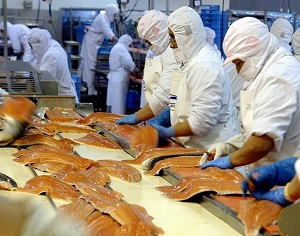Image: Chilean workers process farmed salmon in a plant in Puerto Ibanez near the town of Aysen, in the Chilean Patagonia region, some 1660 km (1031 miles) south of Santiago, in this May 24, 2006 file photo.
![]()
By Anthony Esposito
SANTIAGO (Reuters) – A deadly algal bloom has hit the world’s second biggest salmon exporter, Chile, where nearly 23 million fish have already died and the economic impact from lost production is seen soaring to $800 million, industry and government sources told Reuters.
There are so many dead fish, they could easily fill 14 olympic-size swimming pools, said Jose Miguel Burgos, the head of the government’s Sernapesca fisheries body.
Unusually high ocean temperatures, due in large part to the El Niño weather phenomenon, have fueled the algal bloom that has affected 37 of the nearly 415 salmon farms operating in southern Chile. Most of the farms are in ocean enclosures or in estuaries.
“Temperatures are 2 to 4 degrees (Celsius) above average for this time of the year, there’s a lot of sunlight, a lack of rain and very mild winds, all of which are conditions for the micro algae to appear,” said Burgos.
El Niño leads to hotter sea temperatures in the west Pacific Ocean, which means more rain falls on South America and less in Australia and South East Asia.
But for Liesbeth van der Meer, who heads the Oceana environmental group in Chile, runoff from neighboring livestock creates concentrations of nitrogen that when mixed with the above-normal temperatures, create the ideal scenario for the algae to grow.
Salmon farms near the southern city of Puerto Montt and the Chiloe island have borne the brunt of the toxic algal bloom.
Producers Marine Harvest, Australis Seafoods, Compania Pesquera Camanchaca, Blumar, Multiexport Foods, Cermaq Group AS and Empresas AquaChile have all seen some of their salmon farms affected, according to data provided by the Economy Ministry and company filings with Chile’s SVS securities regulator.
“The loss is likely equivalent to somewhere between 15 and 20 percent of Chile’s total production for the year … the forecast for 2016 was around 750,000 to 760,000 tonnes but now that’s reduced to around 650,000 tonnes,” said Burgos.
The 100,000 tonnes in lost production, which includes Atlantic salmon, Coho and trout, is equivalent to some $800 million in exports, he added.
Chile, the second largest salmon producer after Norway, last year exported $4.5 billion of farmed salmon, on 800,000 tonnes of shipments.
Additionally, the situation will likely lead to job losses in the sector, according to industry group SalmonChile.
Cutting their losses, producers convert those fish that can be saved into fishmeal, while the fish killed by the algal bloom are not destined for human consumption, the group added.
The latest blow to the local industry comes as Chile’s salmon farmers are using record levels of antibiotics to treat a virulent and pervasive bacteria, driving away some U.S. retailers.
(Reporting and writing by Anthony Esposito; Additional reporting by Antonio de la Jara; Editing by Sandra Maler)
Copyright 2015 Thomson Reuters. Click for Restrictions.
Chile-s-Salmon-Farms-Losing-Up-to-800-Million-from-Algal-Bloom-media.jpg


